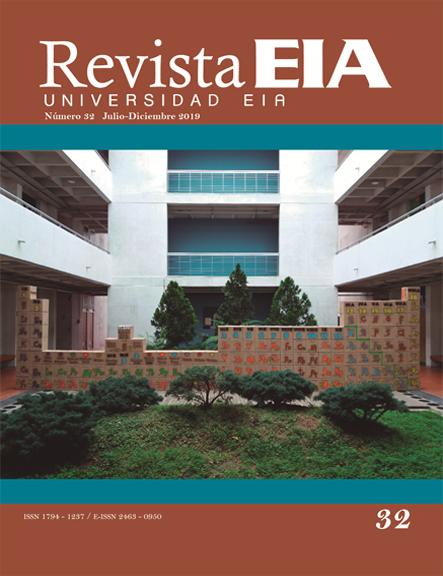Intervención tecnológica para la reconversión y automatización de una máquina termoformadora por vacío de una sola estación
Intervención tecnológica para la reconversión y automatización de una máquina termoformadora por vacío de una sola estación

Copyright statement
The authors exclusively assign to the Universidad EIA, with the power to assign to third parties, all the exploitation rights that derive from the works that are accepted for publication in the Revista EIA, as well as in any product derived from it and, in in particular, those of reproduction, distribution, public communication (including interactive making available) and transformation (including adaptation, modification and, where appropriate, translation), for all types of exploitation (by way of example and not limitation : in paper, electronic, online, computer or audiovisual format, as well as in any other format, even for promotional or advertising purposes and / or for the production of derivative products), for a worldwide territorial scope and for the entire duration of the rights provided for in the current published text of the Intellectual Property Law. This assignment will be made by the authors without the right to any type of remuneration or compensation.
Consequently, the author may not publish or disseminate the works that are selected for publication in the Revista EIA, neither totally nor partially, nor authorize their publication to third parties, without the prior express authorization, requested and granted in writing, from the Univeridad EIA.
Show authors biography
Este artículo presenta el proceso de reconversión y automatización de una máquina de termoformado por vacío, de una sola estación y de operación manual, partiendo de un diagnóstico con el cual se identifican los componentes, capacidades y operación de los sistemas y su accionar como conjunto; se facilita elaborar el rediseño de los sistemas mecánico y neumático y el diseño de los sistemas térmico, eléctrico y de control, para la fabricación, ensamble y puesta a punto. Con la termoformadora automatizada fue posible el funcionamiento secuencial para trabajo en serie con temperaturas controladas, niveles superiores de calentamiento, disminución del consumo energético y una adecuada interacción máquina-operario para el ajuste de las variables y la caracterización del proceso de termoformado sobre cada material. La actualización y automatización propuesta para este tipo de máquinas representa una alternativa de capacidad tecnológica con un importante beneficio potencial para las pequeñas empresas del sector de formado de plástico.
Article visits 772 | PDF visits 458
Downloads
- Albadawi, Z., Boulet, B., DiRaddo, R., Girard, P. and Thomson, V. (2006). Agent-based control for thermoforming processes. 12th IFAC/IFIP/IFORS/IEEE/IMS Symposium Information Control Problems in Manufacturing, Saint-Etienne, France, 17-19 May 2006, pp. 465-470. –Disponible en: http://www.emse.fr/incom06/publication.html [Consultado 21 de abril 2017].
- Bhattacharyya D., Bowis M. and Jayaraman, K. (2003). Thermoforming woodfibre–polypropylene composite sheets. Composites Science and Technology, 63, April, pp. 353-363.
- DiRaddo, R. W., & Meddad, A. (2000). Sensitivity of operating conditions and material properties for thermoforming process. Plastics, rubber and composites, 29(4), pp 163-167.
- Drobney, J. G., (2007). Handbook of thermoplastic elastomers. New York: William Andrew Inc., pp. 216-217.
- Dua, C., Chenb, S. and Lianga, X. (2011). Application of Fuzzy theory in temperature control system of thermoforming machine. Advanced in Control Engineering and Information Science, 15(1), pp. 639-643.
- Dubois, J. H. (1972). Plastics history. Boston, MA: Cahners Books, pp. 73-74.
- Engelmann, S. (2012). Advanced thermoforming: methods, machines and materials, applications and automation. 8th, New Jersey: John Wiley & Sons, pp. 75-79.
- Funck, R., & Neitzel, M. (1995). Improved thermoplastic tape winding using laser or direct-flame heating. Composites Manufacturing, 6(1), pp 189-192.
- Gauthier, G., & Boulet, B. (2006). Terminal iterative learning control applied to thermoforming machine reheat phase. In Industrial Electronics, 2006 IEEE International Symposium on Industrial Electronics, Montreal, QC, Canada 09-13 July 2006.-Disponible en:https://www.ieee.org/conferences_events/conferences/conferencedetails/index.html?Conf_ID=11163 [Consultado 5 de mayo 2017].
- Girard, P., Di Raddo, R., Thomson, V., & Boulet, B. (2005). Advanced in-cycle and cycle-to cycle on-line adaptive control for thermoforming of large thermoplastic sheets. SAE Technical Paper, [e-journal]. https://doi.org/10.4271/2005-01-1520.
- Klein, P. (2009). Fundamentals of plastics thermoforming. Synthesis Lectures on Materials Engineering, 1(1), pp 1-97.
- Kutz M. (2011), Applied plastics engineering handbook processing and material. 2nd ed. New York: William Andrew Inc, pp. 95-96.
- Li, Z. Z., Ma, G., Xuan, D. J., Seol, S. Y., & Shen, Y. D. (2010). A study on control of heater power and heating time for thermoforming. International Journal of Precision Engineering and Manufacturing, 11(6), pp 873-878.
- Ming, P., Meng, P., Wen, C. and Ishak, Z. (2014). Carbon footprint calculation for thermoformed starch-filled polypropylene biobased materials. Journal of Cleaner Production, 64, pp. 602-608.
- Rosen, S. R. (2002). Thermoforming: improving process performance, Dearborn, Michigan: Society of Manufacturing Engineers, pp 274-275.
- Throne, J. L. (2008). Understanding thermoforming. 2nd ed, Dunedin: Hanser Gardner Publications, pp. 171-176.
- Wiesche, S. (2004). Industrial thermoforming simulation of automotive fuel tanks. Applied thermal engineering, 24, April, pp. 2391-2409.
- Zhang, Z. G., Lin, C., Feng, D. K., & Still, R. (2010). Improving plastic thermoform quality with Uniform Heating Technology. In Advanced Materials Research, 97(1), pp. 204-208.




